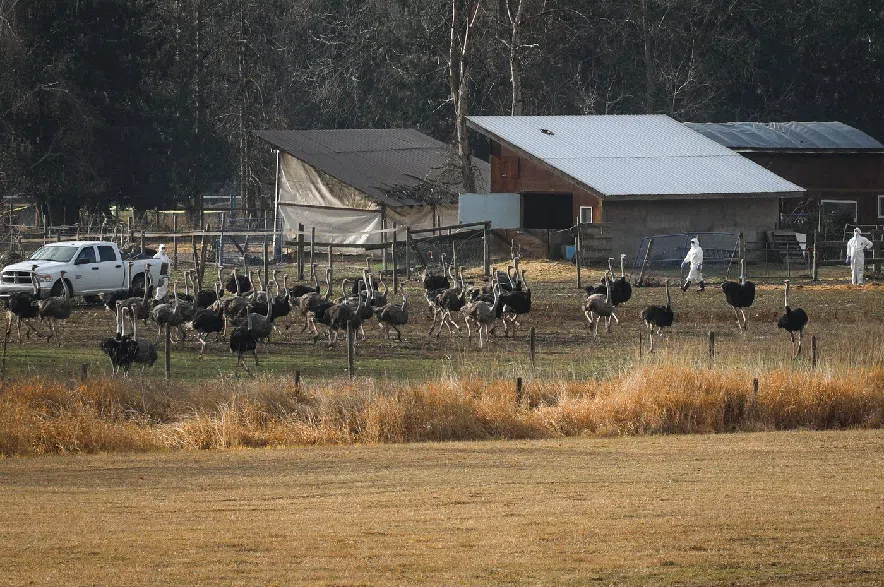Infectious disease veterinarian Scott Weese says the hundreds of ostriches shot dead on a rainy night at a British Columbia farm this month “probably weren’t infected” with avian influenza at the time of the cull by the Canadian Food Inspection Agency.
The problem, says Weese, is that “we don’t really know,” and logistical challenges and conditions at the farm would have hindered rigorous testing of all of the birds.
Read more:
- Five things to know about ostrich cull case, after court delivers blow to farmers
- Gunshots herald ostrich cull after police limit access to British Columbia farm
- ‘Deep burial’ for ostriches at B.C. landfill as CFIA completes cull and disposal work
The H5N1 avian flu virus — detected in the flock of more than 300 ostriches months earlier, prompting a battle by the farm to prevent the cull — cannot be controlled by hoping for the best, says Weese, a professor and infectious disease expert at the Ontario Veterinary College based at the University of Guelph.
“And that’s what we would have been doing here.”
As the owners of Universal Ostrich Farms in southeastern B.C. and their supporters continue to protest over the Nov. 6 cull, Weese is among experts who say there are legitimate questions about the CFIA’s methods and transparency.
But they say a balance must be struck between animal welfare and protecting human health while upholding international responsibilities for managing the virus.
Weese and Vancouver-based lawyer Victoria Shroff, who specializes in animals and the law, both saw areas where they said the CFIA could provide greater clarity.
The CFIA repeatedly said ahead of the cull it would not share details of its operation. Millions of poultry have been killed under its “stamping out” policy to curtail the spread of avian flu in flocks and, potentially, to people.
Shroff said current legislation makes clear the CFIA has broad discretion to order culls. “But I think people are questioning the need for more transparency and clarity on process,” she said in an interview.
“Was there any other possibility here? Or was it just ultimately too risky for human health and biosecurity?”
Weese wrote of the outbreak on his “Worms and Germs Blog” that while the farmers “handled it horribly … nothing bad” in terms of disease spread seems to have come from it.
But he said the stakes were too high to leave anything to chance about H5N1, which scientists fear could mutate into a form easily spread among humans.
“(We) just got lucky, and you only get lucky so many times with a high consequence infectious disease that has pandemic potential,” Weese wrote the day after the cull.
‘YOU CAN’T DRAG THINGS OUT’
Weese said the situation on the ostrich farm near tiny Edgewood in southeastern B.C. unfolded amid an “unprecedented” uptick in avian flu globally. There are 28 premises currently listed as infected in B.C., mostly in commercial poultry farms in the Fraser Valley, east of Vancouver and on the path of migratory birds.
The CFIA’s website shows more than 9.6 million birds have been culled or have died of illness since 2022 in a total of 266 outbreaks in the province.
“Typically with (highly pathogenic) avian flu, you get an introduction and you eradicate the affected birds and it just disappears back into nature,” Weese said.
But since late 2021, scientists have been monitoring the spread of H5N1, a subtype of avian flu, “and it hasn’t gone away,” Weese told The Canadian Press.
Shawn Hall, director of the B.C. Poultry Industry Emergency Operations Centre, said the industry’s priority was doing everything possible to avoid infection and spread.
B.C.’s chief veterinary officer proactively issued an order to move poultry flocks inside to reduce the risk of infection in mid-September, while the industry moved to its “red” biosecurity level, reflecting the highest of three levels of risk, Hall said.
The scope of the avian pandemic and its persistence over multiple years is “really surprising and not something seen before this virus,” Weese said.
And the more the virus spreads, the greater the risk it will infect mammals, including humans, and potentially become what Weese called a “true human virus.”
It was against this backdrop that ostriches started dying on the farm last December. Sixty-nine would go on to perish of illness. But the owners, Karen Espersen and Dave Bilinski, did not inform the CFIA as required by law.
Instead, the CFIA intervened on Dec. 28 to impose quarantine measures after getting an anonymous tip. On Dec. 31, tests on two dead ostriches came back positive for avian flu and the CFIA ordered the cull less than an hour later.
In the months that followed, the farmers went to court and claimed the birds had “herd immunity,” making them valuable for scientific research. They called on supporters to rally at the farm and drummed up support on social media, where many decried the cull order as government overreach.
Their cause drew attention from south of the border, with U.S. Health Secretary Robert F. Kennedy Jr. asking the CFIA to reconsider.
But the farmers’ hopes were dashed when the Supreme Court of Canada announced on Nov. 6 that it would not hear their case.
The cull went ahead that night in cold, drenching rain, with sounds of gunfire starting at about 6 p.m. from inside a large hay-bale pen built by CFIA officials.
Espersen’s daughter, Katie Pasitney, called the shooting inhumane.
The day after the cull, Pasitney told The Canadian Press the CFIA’s stamping-out policy is “broken” and the ostrich farm was “ground zero” for sparking change.
In a subsequent statement, the farm owners said they proposed a risk management plan including isolation, testing and monitoring, but the CFIA “ignored” them. “We were met with bullets instead of dialogue,” it said.
Weese said there is a discussion to be had about the CFIA’s approach to culling.
Ultimately, the answer may be that avoiding a cull is “almost never possible,’ he said, and in any case, the mortality rate among infected chickens and turkeys is so high most commercial poultry farmers don’t seek exemptions. Compensation following a cull depends upon co-operation with the CFIA, according to its policies.
But if there was to be a path to potentially exempt a flock, Weese said it would have to be clearly laid out, with a strict time frame along with experts and decision-making criteria lined up in advance. There could be no process for appeal.
“You can’t drag things out because every day that a bird’s out there being exposed to other birds and people, that’s a transmission risk,” said Weese.
The ostrich farmers had repeatedly called for testing of their flock.
But Weese — who wrote on his blog that it was “very unlikely” the birds were immune to H5N1 — said the idea was problematic. The property lacked appropriate facilities to isolate, test and monitor each bird, he said. There was no infrastructure to keep the ostriches indoors, nor to safely secure their heads for swabbing.
“When you’ve got poor facilities, you do have pretty significant injury risk to people working with those big birds,” Weese said.
Hypothetically, even if all surviving birds in an infected flock were tested and the results came back negative, he said officials would need to show the outbreak was contained in order to meet international responsibilities and protect poultry exports.
But Weese said that wouldn’t have been possible on the ostrich farm with its large flock kept outdoors and regularly exposed to wild birds.
“When you’ve got a flock that’s on a farm where they hid the disease at the start and they did everything contrary to what we’d expect to see for disease control, I’m not sure there’d be much confidence in the international community or within Canada that if something happened, they’re going to be transparent.”
The CFIA has said its stamping-out policy for avian flu is necessary to protect human and animal health, as well as access to international trade, pointing to Canada’s $6.8-billion domestic poultry industry and $1.75 billion in exports.
Weese said he would like to see the agency provide clarity around the potential for exemptions to culling in general, as well as what led it to use marksmen to cull the ostriches.
“The gunfire thing certainly wasn’t appealing, and it would be nice for (the CFIA) to be able to say, ‘Here are all the things we looked at, we ruled them out, based on these experts,’ because I assume that’s what happened,” he said.
The CFIA said after the cull that it determined using professional marksmen was “the most appropriate and humane option” after consulting experts experienced in managing disease among ostriches. It did not directly respond to questions about the farmers’ view of the cull as inhumane or the specific reasons it used marksmen.
Instead, the agency referred to a Nov. 13 statement saying it had completed its active operations at the farm, including disposal of the ostriches through “deep burial” in a B.C. landfill, and providing the farmers with disinfection requirements.
‘HIERARCHY OF INTERESTS’
Lawyer Shroff said the farm’s case illustrated the “marginal status of animals as property” in a system that prioritizes economic and biosecurity concerns.
She said she held a “very pro-animal stance,” while acknowledging the array of factors at play beyond animal welfare, including public health, the safety of farm workers, food safety, consumer trust and economic considerations.
“I think really we’re talking about looking at trying to find a balance here in this hierarchy of interests,” she said, adding animals are often at the bottom of the list.
Short of a total recast of how animals are treated under the law, Shroff said she would like to see “modernized” policies that strive for animal welfare.
“It’s a big ask, but I think it’s something we need to address because of the number of animals that are killed … especially post the pandemic era.”
Hall, from the B.C. Poultry Industry Emergency Operations Centre, said culls are emotionally and financially challenging for farmers.
“But no farmer wants to see their animals suffer,” he said. “So we understand that culling the flock is the responsible action to take for animal welfare, unfortunately, and also a measure that helps prevent the potential spread to other farms.”
He declined to comment on specifics of the situation at the ostrich farm, but said speed was crucial for biosecurity during an outbreak.
“By having a rapid response, we’re reducing the risk that the virus might spread to other farms or wild birds in the area, but also protecting the health of farm workers.”
Weese said the saga of Universal Ostrich Farms had resulted in “valid” questions about the CFIA’s approach and potential lessons for the agency.
“I think in terms of the people that are moving toward this mistrust, misinformation side, the more the CFIA can do to kind of rebuild trust will be important, and I think transparency will be part of that,” he said.











